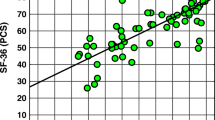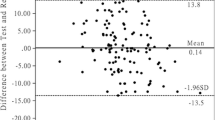Abstract
Purpose
To date, the “Rotator Cuff Quality of Life” (RC-QOL) measure has not been translated into Turkish. The aim of this study was to perform a cross-cultural adaptation of the questionnaire and determine the reliability and reproducibility of the “Turkish version of the RC-QOL” (Tur-RC-QOL) questionnaire on Turkish-speaking patients.
Methods
The translation followed an established forward-and-backward translation procedure. Thirty Turkish-speaking, rotator cuff-impaired patients were enrolled in the study. The validity of the Tur-RC-QOL was assessed and compared with the “Shoulder Pain and Disability Index” (SPADI) and the “Western Ontario Rotator Cuff Index” (WORC) using Pearson’s correlation coefficients. A test–retest interval of 2 days was used to assess the reliability. Internal consistency was tested by Cronbach’s alpha, relative reliability with “intraclass correlation coefficient” (ICC), and absolute reliability using the formula for the “standard error of measurement” (SEM).
Results
The Cronbach’s alpha scores were high for the total scores and subheadings of the Tur-RC-QOL, in the range of 0.83–0.98. Excellent test–retest reliability scores were found for the total score and for all parts of the Tur-RC-QOL, with the exception of “Part E”. The ICC score for Part E was relatively lower than other parts (ICC = 0.71), and the SEM score was relatively higher (17.92 %). The Pearson correlation coefficients for the Tur-RC-QOL were high for SPADI (r = 0.90, p < 0.001) and WORC (r = 0.85, p < 0.001).
Conclusions
This study demonstrates that the Tur-RC-QOL is a reliable and valid instrument to assess the quality of life of rotator cuff-impaired patients.
Level of evidence
III.
Similar content being viewed by others
References
Baumgarter TA (1989) Norm-referenced measurement: reliability. In: Safrit MJ, Wood TM (eds) Measurement concepts in physical education and exercise science. Human Kinetics, Champaign (IL), pp 45–72
Beaton DE, Bombardier C, Guillemin F, Ferraz MB (2000) Guidelines for the process of cross-cultural adaptation of self-report measures. Spine (Phila Pa 1976) 25(24):3186–3191
Bumin G, Tüzün EH, Tonga E (2008) The Shoulder Pain and Disability Index (SPADI): cross-cultural adaptation, reliability, and validity of the Turkish version. J Back Musculoskelet Rehabil 21(1):57–62
Cho CH, Jung SW, Park JY, Song KS, Yu KI (2013) Is shoulder pain for three months or longer correlated with depression, anxiety, and sleep disturbance? J Shoulder Elbow Surg 22(2):222–228
Ekeberg OM, Bautz-Holter E, Tveita EK, Keller A, Juel NG, Brox JI (2008) Agreement, reliability and validity in 3 shoulder questionnaires in patients with rotator cuff disease. BMC Musculoskelet Disord 9:68
El O, Bircan C, Gulbahar S, Demiral Y, Sahin E, Baydar M, Kizil R, Griffin S, Akalin E (2006) The reliability and validity of the Turkish version of the Western Ontario Rotator Cuff Index. Rheumatol Int 26(12):1101–1108
Fleiss JL (1986) Analysis of data from multiclinic trials. Control Clin Trials 7(4):267–275
Hollinshead RM, Mohtadi NG, Vande Guchte RA, Wadey VM (2000) Two 6-year follow-up studies of large and massive rotator cuff tears: comparison of outcome measures. J Shoulder Elbow Surg 9(5):373–381
Huber W, Hofstaetter JG, Hanslik-Schnabel B, Posch M, Wurnig C (2005) Translation and psychometric testing of the Rotator Cuff Quality-of-Life Measure (RC-QOL) for use in German-speaking regions. Z Rheumatol 64(3):188–197
Kirkley A, Alvarez C, Griffin S (2003) The development and evaluation of a disease-specific quality-of-life questionnaire for disorders of the rotator cuff: the Western Ontario Rotator Cuff Index. Clin J Sport Med 13(2):84–92
Longo UG, Saris D, Poolman RW, Berton A, Denaro V (2012) Instruments to assess patients with rotator cuff pathology: a systematic review of measurement properties. Knee Surg Sports Traumatol Arthrosc 20(10):1961–1970
MacDermid JC, Solomon P, Prkachin K (2006) The Shoulder Pain and Disability Index demonstrates factor, construct and longitudinal validity. BMC Musculoskelet Disord 7:12
Martinelli N, Longo UG, Marinozzi A, Franceschetti E, Costa V, Denaro V (2011) Cross-cultural adaptation and validation with reliability, validity, and responsiveness of the Italian version of the Oxford Hip Score in patients with hip osteoarthritis. Qual Life Res 20(6):923–929
Mousavi SJ, Hadian MR, Abedi M, Montazeri A (2009) Translation and validation study of the Persian version of the Western Ontario Rotator Cuff Index. Clin Rheumatol 28(3):293–299
Papalia R, Osti L, Leonardi F, Denaro V, Maffulli N (2010) RC-QOL score for rotator cuff pathology: adaptation to Italian. Knee Surg Sports Traumatol Arthrosc 18(10):1417–1424
Paul A, Lewis M, Shadforth MF, Croft PR, Van Der Windt DA, Hay EM (2004) A comparison of four shoulder-specific questionnaires in primary care. Ann Rheum Dis 63(10):1293–1299
Razmjou H, Bean A, van Osnabrugge V, MacDermid JC, Holtby R (2006) Cross-sectional and longitudinal construct validity of two rotator cuff disease-specific outcome measures. BMC Musculoskelet Disord 7:26
Roach KE, Budiman-Mak E, Songsiridej N, Lertratanakul Y (1991) Development of a Shoulder Pain and Disability Index. Arthritis Rheum 4(4):143–149
Williams JW Jr, Holleman DR Jr, Simel DL (1995) Measuring shoulder function with the Shoulder Pain and Disability Index. J Rheumatol 22(4):727–732
Conflict of interest
None.
Author information
Authors and Affiliations
Corresponding author
Electronic supplementary material
Below is the link to the electronic supplementary material.
Rights and permissions
About this article
Cite this article
Çınar-Medeni, Ö., Ozengin, N., Baltaci, G. et al. Turkish version of the Rotator Cuff Quality of Life questionnaire in rotator cuff-impaired patients. Knee Surg Sports Traumatol Arthrosc 23, 591–595 (2015). https://doi.org/10.1007/s00167-014-3290-0
Received:
Accepted:
Published:
Issue Date:
DOI: https://doi.org/10.1007/s00167-014-3290-0




